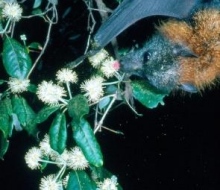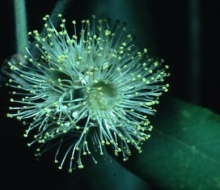Nomadic range and movement
“Grey-headed Flying-foxes occupy forests and woodlands in the coastal lowlands, tablelands and slopes of southeast Australia from Bundaberg to Geelong. They are migratory bats that are primarily found in coastal areas. Few localities support a continuous presence. Rare sightings occur north to Gladstone, west to Adelaide, south to Flinders Island and in inland areas of southern New South Wales and Victoria.” (source: Draft national recovery plan, exec summary)
Grey-headed flying-fox movement
- All grey-headed flying-fox camps are linked into one population
- The number in each camp is influenced by food availability within the surrounding area
- Fluctuations in the size of a camp can vary week by week, month by month or even from one night to the next
- A flying-fox camp has been likened to a railway station where lots of people arrive and depart
- It is known from radio and satellite tracking research that flying-foxes move between camps and individuals are known to travel several thousand kilometres in a year, visiting many camps
- Some grey-headed flying-foxes have been tracked over distances of 1,000km following food sources, but this is not always the case
- Some flying-foxes remain in one camp for much of the year while others move between camps
- In Sydney, numbers are highest in late summer; animals disperse over the winter
- Since 1980 flying-foxes have become permanent city residents, due to increased planting of native trees and an increase in weeds, as their natural habitat has dwindled elsewhere (Puddicombe 1981).
Seasonal movement
Estimates of abundance of the grey-headed flying-fox population were undertaken between 1998 and 2005. These ‘counts’ showed there are discernable shifts in the population.
Winter
In most winters the animals concentrate along the coast in northern NSW and south-east Queensland. The only camps south of Wingham Brush which were occupied were in highly urbanised areas of Sydney and Melbourne where food is available from gardens and street plantings. These camps have been occupied during winter only since 1980 and their combined winter population accounted for only 10 to 12 % of the total. An exception to this general pattern occurs in some winters when spotted gums flower spectacularly on the south coast of NSW.
Autumn
In autumn grey-headed flying-foxes are more dispersed and more likely to be in the southern portion of their range than in winter. They occupy about twice as many camps and it is not uncommon for large camps to be located south of Sydney. At this time of year only 10 to 12% of the population is in Queensland. There are few camps which have been used every count and a large number that have been occupied only once. (from reports by Dr P Eby)
More information:
Australian Goverment Department of Sustainability, Environment, Water, Population & Communities
Species Profile and Threats
Flying-fox movement in 2010
In 2010 prolonged heavy rain and flooding in Queensland and northern NSW signalled the breaking of a long drought. Food for flying-foxes was scarce. This resulted in starving flying-foxes moving inland and south. Flying-foxes were reported feeding on eucalypt blossom in inland towns such as Orange (NSW) and Bendigo (Vic). They also ate apples in orchards in Orange, Tumut (NSW) and Gippsland (Vic). One was found dead in Hobart and several were fed grapes by workers on an oil rig in Bass Strait.

